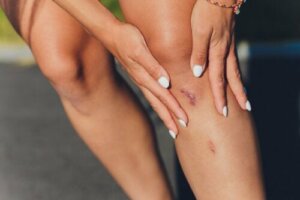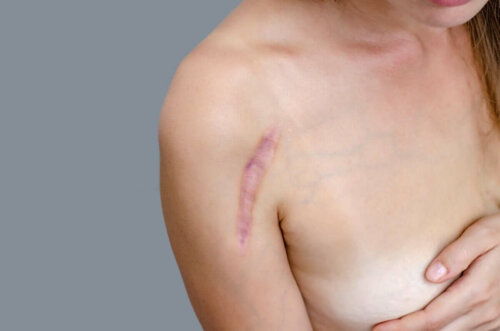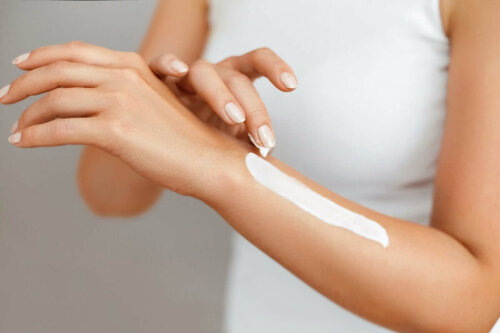How to Care for Scars During the Summer


Written and verified by the dermatologist Maria del Carmen Hernandez
During the summer, it’s important to care for scars that are exposed to the sun’s rays. Although the application of several treatments can help reduce these marks, it’s best to avoid complications due to solar radiation.
Remember that any injury that breaks the surface of the skin causes a scar. Although scars aren’t always permanent, many take years to fade. In this article, discover some recommendations you should consider to ensure that the summer doesn’t negatively affect them.
How scars form
First of all, we should explain how scars form. In general, when the skin is injured, a healing process begins that will vary in duration based on the severity of the injury.
Several phases occur from the injury until healing. The journal of the Spanish Society of Wounds details them as follows:
- Clotting phase. This begins when you receive the wound. When the wound starts to bleed, the body blocks the drainage to stop the bleeding. A scab forms when the clots dry out.
- The inflammation phase. After the scab forms, the immune system responds by preventing possible infections and, in turn, protecting the wound. Blood vessels dilate, thus allowing proper wound irrigation and oxygenation. For this reason, during these days, the area is red and inflamed.
- Proliferative phase. Damaged tissue regenerates and begins to decrease in size during this phase. The body stimulates collagen formation 15 days after the injury.
- Remodeling phase. This begins when the dermis is repaired. This stage can last two years depending on the severity of the injury and ends with the final scar.

This article may interest you: Natural Creams to Reduce the Appearance of Scars
How to care for scars during the summer
Many people consult dermatologists for scars, especially when they formed recently and summer is approaching. If the scar is white (more than a year and a half has passed), special care is no longer required. If not, it’s best to implement the following recommendations.
Wear sunscreen to care for scars
The latest updates published in 2016 by Seminars in Plastic Surgery detailed that newly formed scars (those that are less than 18 months old), are highly susceptible to UV ray damage. In particular, UV rays can cause hyperpigmentation and structural changes in the collagen matrix.
Experts recommend minimizing sun exposure by covering the scar with a bandage or clothing. Also, it’s essential to wear a sunscreen equal to or greater than 50 SPF for 12 to 18 months after the injury.
Apply moderate pressure with silicone gel sheets to care for scars
The use of silicone gel sheets is considered the first recommended line of treatment for recent scars. According to a study published by Aesthetic Plastic Surgery, silicone sheets generate a thin and flexible sheet on the newly scarred wound.
You should use these occlusive dressings during the day and at night for at least 18 hours a day for a three-month period.
Moisturize the area
You need to keep your skin hydrated so that it remains elastic enough to regenerate more effectively. Specific products can help improve the appearance of difficult scars while also moisturizing and producing an emollient effect.
You can also use moisturizing creams that contain vitamins A and E or lotions with hyaluronic acid, as they help to improve the scar. Another option is to apply petroleum jelly, which helps keep the scar in good condition due to its moisturizing power.

This article may interest you: The 7 Best Natural Remedies for Reducing Scars
Massage the scar daily
To promote proper wound healing, it’s also a good idea to massage them. You can start massaging them after the initial healing period, meaning two or three weeks later.
In fact, the journal Advances in Wound Care details that it’s a highly recommended therapy to flatten and soften scars. Massages can lead to more flexible and smoother scars through the degradation of excess and inflexible collagen.
To reap its benefits, it’s best to massage the scar for ten minutes twice a day for at least six months.
It’s important to care for scars during the summer
When the scars are recent and haven’t completed all the phases of the healing process, sun exposure can be very harmful. Therefore, it’s best to avoid direct contact with UV rays during this season of the year.
The daily use of sunscreen, added to other measures such as the application of silicone gel sheets and moisturizing products, mitigates the sun’s harmful effects. Similarly, experts recommend wearing protective clothing.
All cited sources were thoroughly reviewed by our team to ensure their quality, reliability, currency, and validity. The bibliography of this article was considered reliable and of academic or scientific accuracy.
- Al-Shaqsi S, Al-Bulushi T. Cutaneous Scar Prevention and Management: Overview of current therapies. Sultan Qaboos Univ Med J. 2016;16(1):e3-e8. doi:10.18295/squmj.2016.16.01.002
- Commander SJ, Chamata E, Cox J, Dickey RM, Lee EI. Update on Postsurgical Scar Management. Semin Plast Surg. 2016;30(3):122-128. doi:10.1055/s-0036-1584824
- Tziotzios C, Profyris C, Sterling J. Cutaneous scarring: Pathophysiology, molecular mechanisms, and scar reduction therapeutics Part II. Strategies to reduce scar formation after dermatologic procedures. J Am Acad Dermatol. 2012;66(1):13-26. doi:10.1016/j.jaad.2011.08.035
- Gold MH, McGuire M, Mustoe TA, et al. Updated international clinical recommendations on scar management: part 2–algorithms for scar prevention and treatment. Dermatol Surg. 2014;40(8):825-831. doi:10.1111/dsu.0000000000000050
- Mustoe TA. Evolution of silicone therapy and mechanism of action in scar management. Aesthetic Plast Surg. 2008;32(1):82-92. doi:10.1007/s00266-007-9030-9
- https://heridasycicatrizacion.es/images/site/archivo/2014/Revista_SEHER_17_diciembre.pdf
- Klotz T, Munn Z, Aromataris E, Greenwood J. The effect of moisturizers or creams on scars: a systematic review protocol. JBI Database System Rev Implement Rep. 2017;15(1):15-19. doi:10.11124/JBISRIR-2016-002975
- Jourdan M, Madfes DC, Lima E, Tian Y, Seité S. Manejo del cuidado de la piel para procedimientos médicos y estéticos para prevenir la cicatrización. Clin Cosmet Investig Dermatol . 2019; 12: 799-804. Publicado el 25 de octubre de 2019 doi: 10.2147 / CCID.S218134
- Block L, Gosain A, King TW. Emerging Therapies for Scar Prevention. Adv Wound Care (New Rochelle). 2015;4(10):607-614. doi:10.1089/wound.2015.0646
This text is provided for informational purposes only and does not replace consultation with a professional. If in doubt, consult your specialist.








